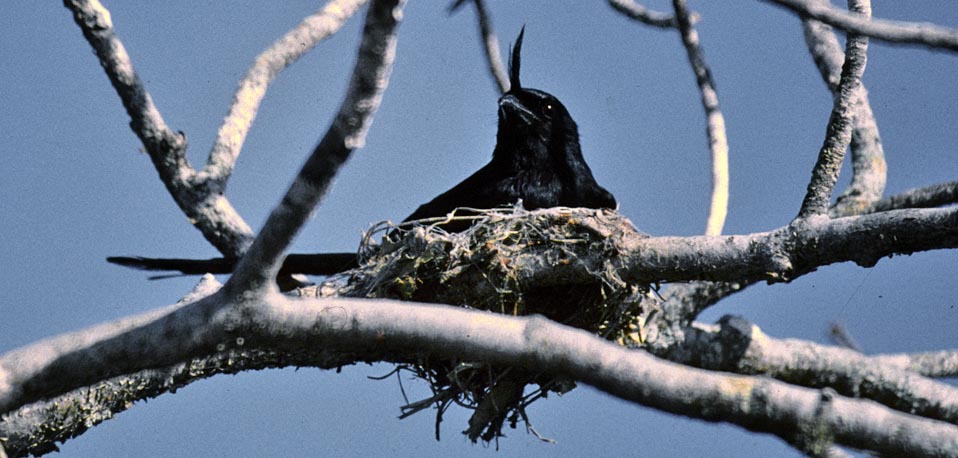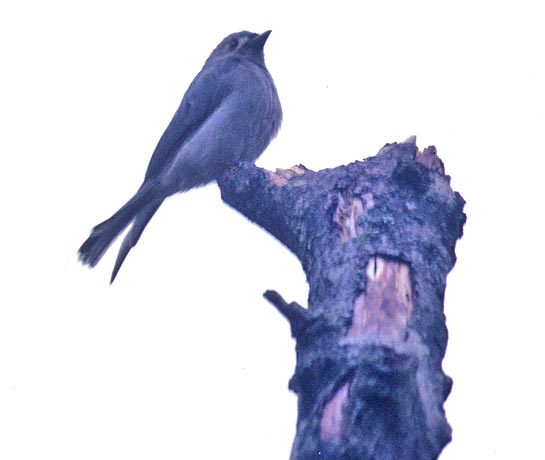
a web page by Don Roberson |
DRONGOS Dicruridae |
|
 The
Drongos are a set of mostly blackish, somewhat crow-like but upright
sitting passerines in the Old World. All 26 species are within the same
genus (Dicrurus) and all are easily recognized as drongos. [A
species traditionally considered to be in a different genus — Papuan
Pygmy-drongo Chaetorrhynchus papuensis — is not a drongo at
all, but an ancient member of the Fantail family Rhipiduridae; Barker
et al. (2004).] Drongos often sit quietly and then sally out after
insects, as do flycatchers, and many have tails that are forked, or
curled up at the tips, or even have racquets. It was once thought that
drongos could be divided into the "primitive" drongos and the
"advanced" or "specialized" drongos (Mayr & Vaurie 1948), with the
latter having a glossy plumage, like Hair-crested Drongo
(left — note the purple or blue gloss on the shoulders and wing), but
this has not proven to be entirely correct evolutionarily. Rather, some
glossy drongos evolved first, but it is true that those with extensive
glossy spangles, complex tail shapes, and most complicated
vocalizations, did typically evolve later as more specialized taxa
(Pasquet et al. 2007). Such birds are often forest species.
Hair-crested Drongo is a lowland jungle bird from eastern India to the
Philippines, Borneo, and Sulawesi. The
Drongos are a set of mostly blackish, somewhat crow-like but upright
sitting passerines in the Old World. All 26 species are within the same
genus (Dicrurus) and all are easily recognized as drongos. [A
species traditionally considered to be in a different genus — Papuan
Pygmy-drongo Chaetorrhynchus papuensis — is not a drongo at
all, but an ancient member of the Fantail family Rhipiduridae; Barker
et al. (2004).] Drongos often sit quietly and then sally out after
insects, as do flycatchers, and many have tails that are forked, or
curled up at the tips, or even have racquets. It was once thought that
drongos could be divided into the "primitive" drongos and the
"advanced" or "specialized" drongos (Mayr & Vaurie 1948), with the
latter having a glossy plumage, like Hair-crested Drongo
(left — note the purple or blue gloss on the shoulders and wing), but
this has not proven to be entirely correct evolutionarily. Rather, some
glossy drongos evolved first, but it is true that those with extensive
glossy spangles, complex tail shapes, and most complicated
vocalizations, did typically evolve later as more specialized taxa
(Pasquet et al. 2007). Such birds are often forest species.
Hair-crested Drongo is a lowland jungle bird from eastern India to the
Philippines, Borneo, and Sulawesi. |
Drongos — at least the open country species like Fork-tailed Drongo or like Crested Drongo (below) — make rather shaggy open-cup nests in the fork of limbs. Crested Drongo is the common open-country drongo of Madagascar. Drongos are also very aggressive when defending nesting territories, and will vigorously attack much larger birds. A Crested Drongo is seen attacking and chasing a Madagascar Cuckoo-Hawk Avicedo madagascariensis (second photo below). |
 |
 |
The other white-bellied, but otherwise black drongo, is a subspecies of the Balicassio D. balicassius of the Philippines. Two races in the north Philippines are black, but subspecies mirabilis of the central Philippines (Negros, Panay, Guimaras, Cebu and related islands) has a well-defined silky-white belly. It has suffered severe declines with the deforestation of most of Cebu and Negros; it is possible that it may be a separate species. |
Drongo taxonomy remains unresolved, especially within the Hair-crested / Spangled complex. Currently, Hair-crested is credited with a wide range in Asia, western Indonesia, and the Philippines, with Spangled Drongo (below) occurring from Halmahera east through New Guinea to Australia and Melanesia. There are probably cryptic species within this complex that have not yet been recognized. |
 |
Photos: The Hair-crested Drongo Dicrurus crepitans was at Dumoga-Bone NP, Sulawesi, Indonesia, in Oct 2011. The Fork-tailed Drongo D. adsimilis was at Kalahari NP, South Africa, on 11 July 2005. The nesting Crested Drongo D. forficatus was at Tulear, Madagascar, in Nov 1992, and the hawk-diving one was at Perinet, Madagascar, that same month. The White-bellied Drongo D. caerulescens was at Tiger Moon Resort, near Ranthambhore, India, in March 2001. The stigmatops Ashy Drongo D. leucophaeus was on Mt. Kinabalu, Borneo, Sabah, Malaysia, in Aug 1988. The Spangled Drongo D. bracteatus was at Foli, Halmahera, Indonesia, on 7 Oct 2011. Photos © Don Roberson; all rights reserved. Bibliographic note: There is no "family book" per se, but a fine introduction to this family, with some excellent photos, is in Rocamora & Yeatman-Berthelot (2009). Literature cited:
|
 Fork-tailed Drongo
(right), a widespread species in subSaharan Africa, is less complex. It
is not a deep-forest birds but is well adapted to a variety of open
woodland habitats, including riparian woodlands and lightly wooded
savannas. It has a gloss to some of its upperparts but is mostly just
an all-black drongo with a red eye and prominently forked tail. It does
have a surprising ability to mimic other birds or sounds in its
landscape, and can perfectly imitate the calls of certain raptors,
bush-shrikes, and owlets.
Fork-tailed Drongo
(right), a widespread species in subSaharan Africa, is less complex. It
is not a deep-forest birds but is well adapted to a variety of open
woodland habitats, including riparian woodlands and lightly wooded
savannas. It has a gloss to some of its upperparts but is mostly just
an all-black drongo with a red eye and prominently forked tail. It does
have a surprising ability to mimic other birds or sounds in its
landscape, and can perfectly imitate the calls of certain raptors,
bush-shrikes, and owlets.  Almost
all the drongos, glossy or not, are black in plumage, making the name
of the common open-country drongo in India and south Asia — Black
Drongo D. macrocercus — rather like overkill. But there are three exceptions in Asia. White-bellied Drongo
is a bird of deciduous and bamboo forests in India and Sri Lanka, and
the Indian population is decidedly white-bellied in plumage (left).
[The Sri Lanka subspecies are white-vented, rather than white-bellied].
Almost
all the drongos, glossy or not, are black in plumage, making the name
of the common open-country drongo in India and south Asia — Black
Drongo D. macrocercus — rather like overkill. But there are three exceptions in Asia. White-bellied Drongo
is a bird of deciduous and bamboo forests in India and Sri Lanka, and
the Indian population is decidedly white-bellied in plumage (left).
[The Sri Lanka subspecies are white-vented, rather than white-bellied].
 The other non-black drongo is Ashy Drongo
(right), with a wide range in Asia. However, based on genetic evidence,
it is believed to have colonized Asia from Africa long ago (Pasquet et
al. 2007). Ashy Drongo has wide variation in both ecology and plumage,
and was once split into two species. The nominate race and relatives
are all ashy-gray in color, but some Chinese and Greater Sunda
subspecies are white-faced or at least white-lored. This bird (right),
from Mt. Kinabalu in north Borneo, is of race stigmatops,
having white on the lores and around the eye. Populations from the
Himalayas through China are migratory, moving south to India and
southeast Asia in winter, while breeding bird of southeast Asia and the
Sundas are primarily resident.
The other non-black drongo is Ashy Drongo
(right), with a wide range in Asia. However, based on genetic evidence,
it is believed to have colonized Asia from Africa long ago (Pasquet et
al. 2007). Ashy Drongo has wide variation in both ecology and plumage,
and was once split into two species. The nominate race and relatives
are all ashy-gray in color, but some Chinese and Greater Sunda
subspecies are white-faced or at least white-lored. This bird (right),
from Mt. Kinabalu in north Borneo, is of race stigmatops,
having white on the lores and around the eye. Populations from the
Himalayas through China are migratory, moving south to India and
southeast Asia in winter, while breeding bird of southeast Asia and the
Sundas are primarily resident.